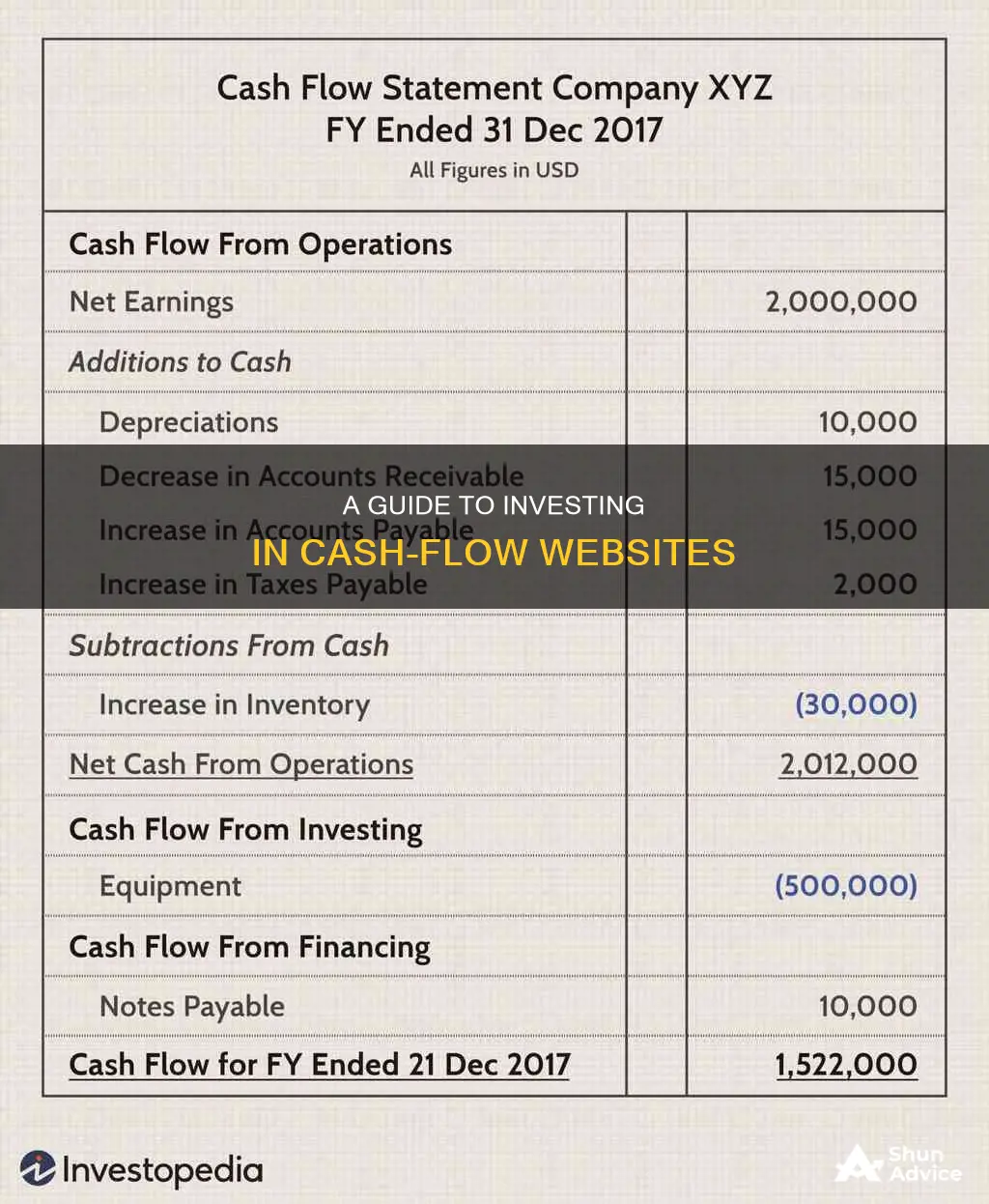
Investing in cash-flow websites is a great way to build an investment portfolio and open up options for earning money online. This type of investment offers flexibility and freedom to work from anywhere with an internet connection. It also provides exceptional returns in a short time frame, with most websites giving a 10-30%+ return on investment per year.
Online businesses are excellent for cash flow investments. They require minimal start-up capital, have rapid scalability, and can deliver swift returns if managed responsibly.
However, investing in websites also entails certain risks, such as shifts in algorithms, the presence of black-hat SEO techniques, and sudden changes in market trends, which can significantly impact a website's traffic, ranking, and revenue.
Overall, investing in cash-flow websites can be a lucrative opportunity, but it's important to be aware of the potential challenges and risks involved.
| Characteristics | Values |
|---|---|
| Type of Investment | Cash-flow websites |
| Investment Options | E-commerce, digital advertising, affiliate promotion |
| Pros | Diversification of portfolio, flexibility, passive income, high returns, low overheads, low startup capital |
| Cons | Algorithm shifts, black-hat SEO techniques, market trend changes, risk of default, high entry threshold, unpredictable cash flow statements |
What You'll Learn

Flipping websites
- Choose the Right Website: Look for a website with solid proof of concept, existing traffic, and revenue. Ensure the website is in a niche with long-term viability and isn't a passing trend.
- Conduct Due Diligence: Research the website thoroughly before purchasing. Evaluate its traffic sources, revenue streams, and growth potential. Use tools like Ahrefs to uncover any technical issues or content gaps.
- Improve the Website: Focus on increasing monthly profit, which will also increase the website's value. Improve SEO, add new content, optimize existing content, and explore additional revenue streams to boost traffic and profitability.
- Value the Website: After a few months or years, the website's value should increase significantly. This is a good time to consider selling to profit from the sale. Websites can be volatile assets, so it's important to take profits when you're happy with the website's performance.
- List the Website for Sale: Prepare the website for sale by gathering all necessary assets and information, including profit and loss statements, revenue proof, and operational procedures. Choose a suitable marketplace to reach potential buyers.
- Negotiate and Close the Sale: Be available to communicate with potential buyers, negotiate terms, and finalize the sale. Ensure a smooth transfer of assets and correct legal contracts.
- Reinvest or Repeat: If you choose to reinvest your profits, you can purchase another website. You can either buy low-priced websites to flip quickly or reinvest in higher-quality websites for longer-term gains.
The skills required for successful website flipping include search engine optimization (SEO), market analysis, and negotiation. By mastering these skills or hiring experts, you can effectively identify and improve websites with high flip potential.
Profits from website flipping can vary widely, ranging from a few hundred dollars to millions. Successful website flippers often earn between $2,000 and $10,000 per month through strategic buying, improving, and selling.
In summary, website flipping offers a location-independent business model with low entry barriers. By buying websites, you can skip the initial building phase and focus on optimizing them for growth. With dedication and practice, website flipping can lead to substantial financial rewards.
How Cashing Investments Affect Debt Service Coverage
You may want to see also

Pros and cons of investing in websites
Investing in websites is a growing trend for people seeking alternative investment opportunities to stocks, real estate, and other traditional investments. It can be a lucrative and somewhat passive investment opportunity, but it's important to understand the potential pros and cons before diving in.
Pros of Investing in Websites:
- Immediate and passive income: Websites can provide a steady stream of passive income through monetization sources like affiliate marketing, subscriptions, and product sales. The monthly payouts of most ad and affiliate programs create a steady passive income that can be reinvested into the site.
- Diversification and flexibility: Investing in websites offers a new form of diversification for your portfolio. It gives you the flexibility to choose how involved you want to be in the day-to-day operations of the business.
- High return on investment (ROI): Websites can potentially generate a high ROI, with some cases showing annual returns upwards of 20%, 50%, or even 100%+. Online businesses have the potential for a full 100% ROI, delivering monthly cash flow faster than interest-dependent investments.
- Scalability: Websites are scalable business opportunities. Through active investment in content marketing, social media growth, and expansion into other monetization opportunities, you can significantly increase revenue and growth.
- Control: You have a significant degree of control over the future earnings of your website. You can drastically increase earnings and sell the site later for a profit.
- Time and effort savings: Buying an established website is much easier than starting from scratch. You can save time and effort by purchasing a profitable website that provides an immediate return on investment, allowing you to focus on growing the business.
Cons of Investing in Websites:
- Higher risk: Websites can be a risky venture, especially for inexperienced investors. A website's traffic and earnings can be significantly impacted by factors like Google algorithm changes, affiliate partner fee changes, or shifts in market trends.
- Active management required: Most websites require active management, including monitoring, publishing new content, refreshing old content, and fixing bugs. While some tasks can be outsourced, website management will never be as passive as investing in the stock market or other traditional investments.
- Dependency on external platforms: The performance of a website often relies heavily on external platforms, such as Google, Shopify, or social media for marketing. Changes to these platforms, which are beyond your control, can significantly affect a website's health and revenue.
- Expensive starting investment: A good, established website with high potential can cost tens of thousands of dollars. This initial investment may be a barrier for some, especially compared to the lower cost of building a website from scratch.
- Susceptibility to scams: There are many scams in the website investing space, especially on platforms that don't vet listings. It's essential to conduct thorough due diligence to avoid buying an overvalued website or falling victim to unscrupulous sellers.
Cash vs Investing: Is Holding Cash Ever Better?
You may want to see also

How to buy a website
Purchasing a website can be a great way to build your investment portfolio and open up new income streams. It can also be a complex process, so here is a step-by-step guide to help you navigate the world of website investing.
Understand the Basics
Before diving into the world of website investing, it is important to understand the basics. A website can be a valuable asset, just like physical real estate. By purchasing an existing website or building one from scratch, you can create a steady cash flow and generate passive income.
Assess the Benefits and Risks
Website investing offers several advantages, including flexibility, diversification, and exceptional returns. You can choose to be hands-on or hands-off with your investment, and you can work from anywhere with an internet connection. Additionally, online businesses often require minimal start-up capital and have unlimited earning potential.
However, there are also risks involved. Shifts in algorithms, black-hat SEO techniques, and sudden changes in market trends can significantly impact a website's traffic, ranking, and revenue. It is crucial to understand these risks before making any investment decisions.
Choose a Website Brokerage Platform
There are several online platforms that specialize in buying and selling websites, such as Flippa.com and Empire Flippers. These platforms allow you to browse available websites for sale, review their traffic and revenue statistics, and connect with sellers.
Conduct Due Diligence
When you find a website that interests you, it is essential to conduct thorough due diligence. Review the website's traffic analytics, revenue sources, and expenses. Assess the website's business model and identify any potential risks or areas for improvement.
Make an Offer
If you are satisfied with your due diligence, it's time to make an offer. Contact the seller and negotiate a fair price for the website. You may also want to consider using an escrow service to ensure a safe and secure transaction.
Post-Purchase Optimization
Once you have successfully purchased a website, you can start optimizing it to increase its value. This may include improving the website's design, content, and SEO to drive more traffic and boost revenue. Remember that you can also choose to build a website from scratch if you prefer.
By following these steps, you can enter the world of website investing with confidence and make informed decisions about purchasing websites. Remember to always conduct thorough research and understand the risks involved before making any investment decisions.
Computing Investment Cash Flows: A Guide to Statement Analysis
You may want to see also

How to build a website
Building a website is a great way to increase your online presence and reach more customers. Here is a step-by-step guide on how to build a website:
Specify a goal for your website:
Determine what you want to achieve with your website. Are you planning to sell products or services? Do you want to showcase your portfolio or build a website for branding purposes? This will help you decide on the types of pages, content, and technical capabilities you'll need.
Research your market and competitors:
Study your target audience and competitors to understand what type of information your potential customers are interested in and what types of content are being published to capture them. Use SEO tools like Ahrefs, Semrush, and Ubersuggest to understand your competitor's site structure and target keywords.
Research visually appealing designs:
Explore website designs that will appeal to your target audience while keeping your website's goal in mind. Decide on a theme, colors, and layout that align with your brand identity and evoke the desired emotions in your audience.
Choose a website builder:
Select a website builder that suits your needs and technical skills. You can code your website from scratch, hire a web developer, or use a drag-and-drop website builder with ready-made templates. Consider factors such as SEO capabilities, content management systems, and the ease of connecting to other tools.
Choose a web host:
Select a web hosting provider to ensure your website's speed, performance, security, and backup. This is crucial for the effectiveness of your website and how your business is perceived by others.
Choose a domain name:
Pick a memorable domain name that reflects your business and is easy for your audience to find. Consider using a custom domain with a reputable extension like .com, as it can enhance your website's reputation and search engine optimization.
Add content and customize the layout:
Add your content, including text, images, videos, contact forms, and social media icons. Customize the website templates to match your branding and ensure mobile optimization for a seamless user experience across devices.
Connect the necessary tools:
Integrate external tools like Google Analytics, Google Tag Manager, and email marketing platforms to track user behaviour, set up events, and collect newsletter subscribers.
Preview and publish:
Proofread your content and test your website on both desktop and mobile devices to ensure functionality and user-friendliness. Once you're satisfied, publish your website, share the link with your audience, and add it to your social media profiles.
Building a website is a process that requires planning, research, and attention to detail. By following these steps, you can effectively create a website that achieves your goals and engages your target audience.
Understanding E-Trade Cash Calls: What Investors Need to Know
You may want to see also

Website business models
There are several ways to generate income through websites, which can be broadly categorized into two types: income-generating investments and appreciation-focused investments.
Income-generating investments focus on acquiring assets that produce a regular income and are suitable for investors seeking steady, predictable returns. This includes dividend-paying stocks, interest from bonds, or rental income from real estate properties.
One popular model for websites is affiliate marketing, where a website owner writes an article on a topic that people are searching for, such as "what's the best microwave". They then include a link to Amazon to purchase that product, and when someone clicks on the link and buys something, the website owner earns a commission. This model can be very successful if the website ranks highly on Google and attracts a lot of visitors.
Another way websites can generate income is through digital advertising. This can be in the form of display ads on the website or through sponsored content, where companies pay to have their products or services featured on the site.
Appreciation-focused investments, on the other hand, aim to purchase assets expected to increase in value over time, with the goal of selling them at a higher price for a profit. Websites can also be a part of this strategy, as they can be bought, improved, and then sold for a higher price. This model can be very lucrative, but it also comes with higher risks due to the unpredictable nature of asset appreciation, which can be influenced by market trends and algorithm changes.
Additionally, websites can be a source of passive income, requiring minimal ongoing work once they are established. This makes them a desirable investment for those seeking to generate cash flow with less active involvement over time.
Overall, investing in websites offers a new form of diversification for an investment portfolio and provides the flexibility to work from anywhere with an internet connection.
Extra Cash? Here's How to Invest Wisely
You may want to see also
Frequently asked questions
Investing in cash-flow websites offers a new form of diversification for your portfolio and gives you the flexibility to work from anywhere with an internet connection. You can choose to be as hands-on or hands-off as you like.
Investing in cash-flow websites carries certain risks, such as shifts in algorithms, the use of black-hat SEO techniques, and sudden changes in market trends. These factors can significantly impact a website's traffic, ranking, and revenue, ultimately affecting your investment.
Before investing in cash-flow websites, it is recommended that you start your own website or buy an existing one to learn the ropes and gain a better understanding of how they work. This will help you avoid costly mistakes and make more informed investment decisions.







